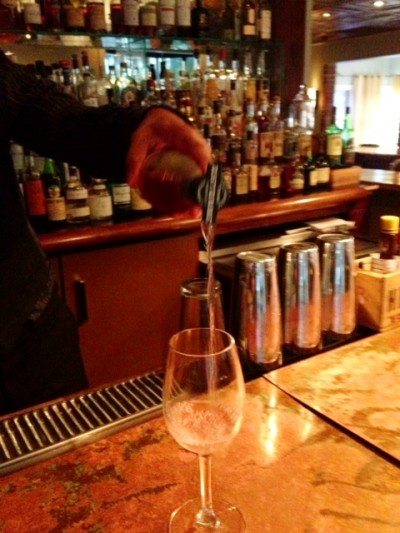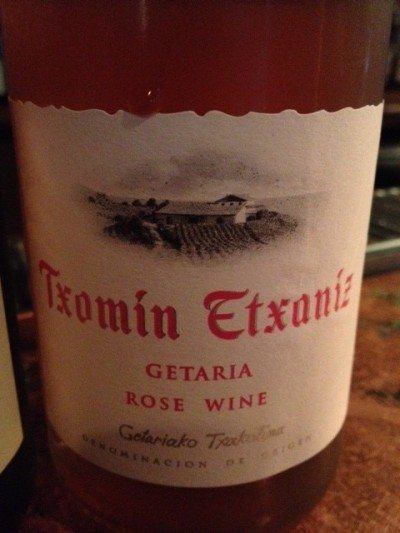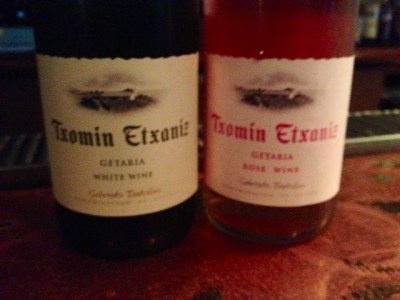Normally, I think of Txakoli, Txakolina, or phonetically represented chockoleena in easy-drinking aperitif terms; refreshing, simple, high acidity, dazzling spritz, low alcohol. However you say or spell it, the wine pairs particularly well with seafood and a wider range of pintxos, casually served in tumblers inside Spain’s Basque region taverns. If you will, these wines remind me of little dance parties in a glass. Tongue tying pronunciations aside, how bad can a wine be made from locally grown red Hondarribi Beltza or white Hondarribi Zuria grapes grown here, outside San Sebastian on the Northern Spain coastline?
Lately I’ve been hanging out at Woodfire Grill a lot, just down the street from my Atlanta pied-à-terre, mostly because Chef Tyler Williams and Sommelier Patrick Guilfoil have dialed directly into my food and wine sweet spot. The restaurant serves up the most creative food and interesting wine list in Atlanta. This time, as my guest ran late in the city’s endemic gridlock and I sat without moving at the bar, I ordered a glass of 2012 Txomin Etxaniz Txakoli Rosé Getariako just to pass time.
Getariako is one of the important Txakoli DOs, and the Txomin Etxaniz rosé is a deserving poster child. Woodfire direct imports the wine and pours from traditional agitative heights. Actually, a specialized Txakoli pouring device is used that further helps mix air with wine. It’s called an escanciador.
 That’s a lot of fuss and tradition for simple wine, but it’s part of the fun nonetheless. With all the service drama, I wasn’t focused enough on this Getariako version at first pass. Guilfoil stopped over to admit this was his personal favorite rosé in the world, not just Northern Spain. That’s a heavy statement, especially considering Patrick’s depth of knowledge and tasting experience, and I was surprised he fell in love with rosé in Basque country as opposed to Bandol, Loire, or Languedoc. With the pouring pomp and circumstance behind us, the wine drew me in.
That’s a lot of fuss and tradition for simple wine, but it’s part of the fun nonetheless. With all the service drama, I wasn’t focused enough on this Getariako version at first pass. Guilfoil stopped over to admit this was his personal favorite rosé in the world, not just Northern Spain. That’s a heavy statement, especially considering Patrick’s depth of knowledge and tasting experience, and I was surprised he fell in love with rosé in Basque country as opposed to Bandol, Loire, or Languedoc. With the pouring pomp and circumstance behind us, the wine drew me in.
It’s delicate aroma and weight belied a dominant profile of slate and salt. The wine shows a traditional regional citric, edgy, character. Yet, it is head and shoulders over any Txakoli I have tasted yet. The lime citrus, muted spritz, intensive saltiness, floral nose, and powerful crispness leaves a lasting mouth coat that satisfies long after you swallow the wine. The 2012 Txomin Extaniz Txakoli is surprisingly elegant and pretty, standing out among its peers like a rose petal in a scattered rock garden. Actually, the wine is so special that I forgot what was going on around me, enraptured by its grace juxtaposed against stoney edginess and the salinity that certainly must have something to do with its oceanside birthplace. It forced me to forget most everything I knew about Txakolina, and to remain open to embracing a newly discovered wine and producer that will remain forever burned in my wine memory bank.
The 2012 Txomin Extaniz white version shows a dramatically different styled wine, but equally unique inside its Txakolina peer group. While the rosé aromatics are whispy, citric, and clean the white version shows off richness and viscosity at first sniff. Pineapple and peach aromas and flavors add to equally bracing citric acidity, but the wine has a rich malic character that I had not experienced in Txakolina before. It loses the lightness and simple fun of Txakoli, and exchanges it for more serious wine characteristics. It’s a lovely wine in itself, but the rosé stands on a taller global pedestal and is completely remarkable. Without a doubt, Txomin Extaniz makes wine worth chasing. Patrick was right again.
Txakoli is fun from pour to finish. Txomin Extaniz, though, managed to fully captivate my sensory attention. The wines sell for only $20, and they are great. I found a source for Txomin Extaniz in Massachusetts at Table and Vine so hurry up before the little that makes its way into the country is completely snapped up by the rest of us that appreciate pretty, clean, graceful, crisp, stony, salty, and pointedly flavored world class wines.



